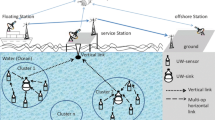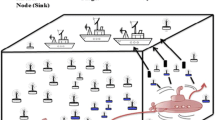Abstract
One of the most popular researches in recent years is UWSN (Underwater Sensor Network). UWSNs are used for various applications and also which is used between different hubs and ground-based stations. Also, this system is mainly used for naval applications like tracking and detecting submarines. The process of localization of the target is fundamental to detecting submarines. So, in this paper, a novel model of localization of sensor nodes with range-based localization method utilizing the hybrid Spider Monkey Battle Royale Algorithm (hybrid SMBR) is proposed. The place of the submarine is determined using the reflected arrival signal and the direction of arrival. The submarine’s position is then sent to be monitored using an energy-knowledge depth-based routing protocol. The effectiveness of the proposed UWSN system is determined by evaluating different metrics such as localization error, delivery ratio, localization coverage, energy consumption, delay, packet drop, and throughput.
















Similar content being viewed by others
Data availability
Data sharing is not applicable to this article as no new data were created or analyzed in this study.
Code availability
Not applicable.
References
Ahmed S, Ali MT, Alothman AA, Nawaz A, Shahzad M, Shah AA, Ahmad A, Khan MY, Najam Z, Shaheen A (2020) EH-UWSN: improved cooperative routing scheme for UWSNs using energy harvesting. J Sens. https://doi.org/10.1155/2020/8888957
Ali G, Ali T, Hassan IU, Shaf A, Irfan M, Nowakowski G, Kielkowicz K, Glowacz A, Alqhtani SM (2022) A novel routing protocol based on elliptical shaped movement of autonomous underwater vehicles in data gathering process for underwater wireless sensor network. Sensors 22(14):5269
Bai Q, Jin C (2022) A K-means and ant colony optimization-based routing in underwater sensor networks. Mob Inform Syst. https://doi.org/10.1155/2022/4465339
Coutinho RW, Boukerche A, Vieira LF, Loureiro AA (2015) Geographic and opportunistic routing for underwater sensor networks. IEEE Trans Comput 65(2):548–561
Deldouzi S, Coutinho RW (2021) “A novel harvesting-aware RL-based opportunistic routing protocol for underwater sensor networks.” In Proceedings of the 24th International ACM Conference on Modeling, Analysis and Simulation of Wireless and Mobile Systems, pp. 87–94
Gupta O, Goyal N (2021) The evolution of data gathering static and mobility models in underwater wireless sensor networks: a survey. J Ambient Intell Humaniz Comput 12(10):9757–9773
Ismail AS, Wang X, Hawbani A, Alsamhi S, Abdel Aziz S (2022) Routing protocols classification for underwater wireless sensor networks based on localization and mobility. Wireless Netw. https://doi.org/10.1007/s11276-021-02880-z
Javaid N, Muhammad, Sher A, Abdul W, Niaz IA, Almogren A, Alamri A (2017) Cooperative opportunistic pressure based routing for underwater wireless sensor networks. Sensors 17(3):629
Jawhar I, Mohamed N, Al-Jaroodi J, Zhang S (2018) An architecture for using autonomous underwater vehicles in wireless sensor networks for underwater pipeline monitoring. IEEE Trans Industr Inf 15(3):1329–1340
Khan A, Khan M, Ahmed S, Abd Rahman MA, Khan M (2019) Energy harvesting based routing protocol for underwater sensor networks. PloS One 14(7):e0219459
Khan ZA, Karim OA, Abbas S, Javaid N, Zikria YB, Tariq U (2021) Q-learning based energy-efficient and void avoidance routing protocol for underwater acoustic sensor networks. Comput Netw 197:108309
Mohan P, Subramani N, Alotaibi Y, Alghamdi S, Khalaf OI, Ulaganathan S (2022) Improved metaheuristics-based clustering with multihop routing protocol for underwater wireless sensor networks. Sensors 22(4):1618
Murgod TR, Sundaram SM (2021) A comparative study of different network simulation tools and experimentation platforms for underwater communication. Bull Electr Eng Inform 10(2):879–885
Noh Y, Lee U, Lee S, Wang P, Vieira LF, Cui JH, Gerla M, Kim K (2015) Hydrocast: pressure routing for underwater sensor networks. IEEE Trans Veh Technol 65(1):333–347
Pérez-Adán D, Fresnedo Ó, González-Coma JP, Castedo L (2021) Intelligent reflective surfaces for wireless networks: an overview of applications, approached issues, and open problems. Electronics 10(19):2345
RahkarFarshi T (2021) Battle royale optimization algorithm. Neural Comput Appl 33(4):1139–1157
Rodoshi RT, Song Y, Choi W (2021) Reinforcement learning-based routing protocol for underwater wireless sensor networks: a comparative survey. IEEE Access 9:154578–154599
Sandhiyaa S, Gomathy C (2021) A survey on underwater wireless sensor networks: challenges, requirements, and opportunities. In 2021 Fifth International Conference on I-SMAC (IoT in Social, Mobile, Analytics and Cloud) (I-SMAC) (pp. 1417–1427). IEEE
Sharma H, Hazrati G, Bansal JC (2019) Spider monkey optimization algorithm. Evolutionary and swarm intelligence algorithms. Springer, Cham, pp 43–59
Wang Z, Han G, Qin H, Zhang S, Sui Y (2018) An energy-aware and void-avoidable routing protocol for underwater sensor networks. IEEE Access 6:7792–7801
Xu X, Cao S, Yang Y (2021) A comprehensive survey of recent simulation platforms for underwater acoustic sensor networks. In 2021 2nd International Conference on Computing, Networks and Internet of Things. pp. 1–6
Zhu F, Wei J (2018) An energy efficient routing protocol based on layers and unequal clusters in underwater wireless sensor networks. J Sens. https://doi.org/10.1155/2018/5835730
Funding
Not applicable.
Author information
Authors and Affiliations
Contributions
MCR agreed on the content of the study. MCR and MR collected all the data for analysis. MCR agreed on the methodology. MCR and MR completed the analysis based on agreed steps. Results and conclusions are discussed and written together. Both author read and approved the final manuscript.
Corresponding author
Ethics declarations
Conflict of interest
The authors declare that they have no conflict of interest.
Informed consent
For this type of study informed consent is not required.
Consent to participate
Not applicable.
Consent for publication
Not applicable.
Human and animal rights
This article does not contain any studies with human or animal subjects performed by any of the authors.
Additional information
Publisher's Note
Springer Nature remains neutral with regard to jurisdictional claims in published maps and institutional affiliations.
Rights and permissions
Springer Nature or its licensor (e.g. a society or other partner) holds exclusive rights to this article under a publishing agreement with the author(s) or other rightsholder(s); author self-archiving of the accepted manuscript version of this article is solely governed by the terms of such publishing agreement and applicable law.
About this article
Cite this article
Shakila, R., Paramasivan, B. An improvised optimization algorithm for submarine detection in underwater wireless sensor networks. Microsyst Technol 30, 185–196 (2024). https://doi.org/10.1007/s00542-023-05585-9
Received:
Accepted:
Published:
Issue Date:
DOI: https://doi.org/10.1007/s00542-023-05585-9




